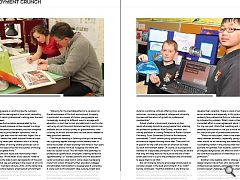Employment Crunch: Hard Lessons
19 Oct 2015
With recruiters warning of a looming skills gap Urban Realm speaks to some of those in the industry who are championing new ways of bringing employers, schools and government together in order to enthuse a new generation with a career in construction as wellas new ways of developing the training programmes and apprenticeships required to meet our needs.
Amongst those voicing concern is GLM managing director Ian McKee who told Urban Realm: “I am faced in my role as chairman of RICS in Scotland and as the managing director of GLM, with two apparently very different but equally challenging problems. On one hand is the issue of the looming skills gap in the built environment sector and on the other is the struggle faced by many professional practices in the SME sector to make a sustainable profit. Challenging problems they certainly are, but are they different or inextricably linked? I believe they are two sides of the same coin.
“Anecdotally we already know there is a skills shortage which at the moment is more pronounced in some parts of the sector than in others but will, in due course, affect us all. This shortage is not just the result of a long and deep recession but is rooted in our long term failure to attract and train young people in anything like the numbers needed to offset the demographic time bomb caused by many of today’s senior professional’s retiring over the next ten to fifteen years.
“Similarly, we find ourselves exasperated by the relentless downward pressure on fees caused to a large extent by ill-considered procurement practices designed and administered by procurement ‘specialists’ with a simple remit to get ever more for ever less. Again, this is a trend set well before the credit induced financial crash and the resulting seven year recession and it is having the inevitable effect of driving smaller practices out of business and mid-sized ones into the clutches of the big multi-national or global firms.“
Outlining how both issues are inextricably linked McKee continued: “At the heart of our sectors’ need for new recruits lies the baby boom demographic of the post war era which will see somewhere in the region of 25 to 30 per cent of our members retire by 2030. At the same time, the number of school leavers entering built environment courses at university is dwindling, compounding the projected skills shortage at a time of rising demand from an improving economy.
“Allowing for the inevitable effect of a recession on the attractiveness of the built environment (property in particular) as a career of choice, young people are increasingly looking for different ways to engage with education, in part due to cost and debt and in part by the vast array of part-time and distance learning options now available and so to focus purely on graduate entry risks us failing to attract the numbers into the sector needed to keep pace with demand.
“On the job learning or ‘earning while you’re learning’ has a growing appeal amongst school leavers keen to avoid the burden of debt resulting from three or four years in academia and so we must recognise this trend and tailor our sector to suit. This will mean new pathways to professional qualification, employers creating attractive ‘apprenticeship’ or ‘trainee’ positions and the education sector providing a clear and in some cases overlapping route from school, through further education colleges and ultimately matriculation to degree level at university. A route such as this shouldn’t take a young, bright and enthusiastic school leaver any longer than the current full time study route and has clear advantages for all the stakeholders – less personal debt, a younger more dynamic workforce, schools offering more positive outcomes, increasing uptake of college and university courses and the return of growth to professional membership.”
Asked whether a downward pressure on fees would ultimately disincline young people from entering the profession professor Alan Dunlop, architect and visiting professor at visiting Professor at Robert Gordon University, Scott Sutherland School of Architecture, commented: “I don’t believe young people start an architecture degree thinking about fees. They start full of passion for the craft and with an ambition to make our built environment better. Of course, as a prospective member of a respected profession I’m sure they are aware that they will likely have to find a job at the end of their seven years and it is up to the profession and universities to equip them to do that.”
But can more be done to encourage school pupils to consider careers in the built environment? If so, what? Dunlop continued: “Youthful ambition is one thing but practical reality another. It is clear that architecture remains a very expensive option for study and that many talented young people never get the opportunity to develop their potential. There is a lack of outreach activity across academe and especially in this protracted period of austerity few professional firms or individuals do anything to mitigate this problem. What’s clear is that there is no concerted effort or even agreement about the solution. For my own part I think that coaching and mentoring by seasoned practitioners is not just a moral responsibility but should be part of professional practice
“Whilst on the subject, there is the matter of why so many talented architects, especially young women, leave what should be an interesting and rewarding career. There is something rotten in the practice that most architects just take for granted. Few students, even those from privileged backgrounds can afford to work for nothing and the continued expansion of internships is a disgrace to the profession.”
Another voice leading calls for change is that of Keppie design director David Ross who, along with a number of invited business leaders, participates in the Interaction Schools Design Challenge, an initiative organised in conjunction with East Ayrshire Council and Ayrshire College to encourage secondary school pupils to consider careers in architecture. Ross said: “My idea was to develop an annual creative design initiative, which would be part of each school’s core curriculum. It was based on our own internal work experience programme, which we developed in partnership with the Mackintosh School of Architecture to give young people a condensed taste of what might face them if they went on to study there.
“The plan for this year’s Interaction is just forming but essentially the Council are funding the construction of a number of school designed initiatives in each of the nine secondary schools. I’ve also been asked to curate an East Ayrshire Exhibition for the Festival of Architecture 2016 and I’m contemplating part of that being a showcase on Interaction.”
Whilst political meddling in education has made any form of experimentation a dirty word Ross was nevertheless able to produce the template for an elective creative design qualification with the ultimate aim of establishing a local architecture course in the region. Ross continued: “In general terms, architects engage far less with the communities in which we operate than we like to admit, given that listening and communicating with those who experience our work is an essential part of the job. This could be as a consequence of a gulf between education and practice which has already been recognised by many educators. By addressing this issue there is an opportunity for architectural practices to become directly involved in changing how the profession is perceived.
“It is my view that more practices need to collaborate with, and support, the wider spectrum of education in order to protect, nurture and ultimately strengthen the profession for the future.”
This view is shared by McKee who concluded: “We need an attractive proposition to sell. We need to inspire the next generation to be surveyors, architects, engineers, construction managers and the like. This is where I believe the two problems mentioned earlier converge. If the very businesses that need these young, bright and enthusiastic professionals of tomorrow are not in themselves sustainably profitable, then how can we compete for their talents against industries or sectors that are? Our race to the bottom by bidding for poorly procured work, engaging with groups and bodies that value only price and are not willing or able to pay for great design, innovation and professionalism, needs to stop. We must disengage with these processes and push back if we are to secure the future of our sector and once again become the career of choice for a future generation.”
It is easy to dismiss long-term demographic shifts in favour of short-term considerations but the need to take action to head off future crises grows more urgent by the day. It is heartening therefore that industry hasn’t just identified the problem but is now taking active measures to tackle them.
|
|
Read next: The Power of Place
Read previous: Ronald McDonald House: Home From Home
Back to October 2015
Browse Features Archive
Search
News
For more news from the industry visit our News section.
Features & Reports
For more information from the industry visit our Features & Reports section.





